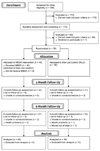Mindfulness-based stress reduction for HIV treatment side effects: a randomized, wait-list controlled trial
- PMID: 21925831
- PMCID: PMC3253947
- DOI: 10.1016/j.jpainsymman.2011.04.007
Mindfulness-based stress reduction for HIV treatment side effects: a randomized, wait-list controlled trial
Abstract
Context: Advances in antiretroviral therapy (ART) for HIV offer life-extending benefit; however, the side effects associated with ART use negatively impact quality of life and medication adherence among people living with HIV.
Objectives: This study tested the efficacy of Mindfulness-Based Stress Reduction (MBSR) for reducing ART symptoms and bother/distress related to ART side effects. Secondary aims were to test the impact of MBSR on medication adherence and psychological functioning.
Methods: Seventy-six people living with HIV who were actively taking ART and reported distress from ART-related side effects were randomly assigned to an MBSR program or a wait-list control (WLC) standard care condition. We measured side effects, ART adherence, perceived stress, depression, positive and negative affect, and mindfulness at three time points: baseline, three-month follow-up, and six-month follow-up. Side effects and related distress were assessed separately from other symptoms.
Results: Compared with a WLC, participants in the MBSR condition experienced a reduction in the frequency of symptoms attributable to ARTs at three months post-intervention (mean difference=0.33; 95% confidence interval [CI]=0.01, 0.66; t(132)=2.04, P=0.044) and six months post-intervention (mean difference=0.38; 95% CI=0.05, 0.71; t(132)=2.27, P=0.025). MBSR participants also experienced a reduction in distress associated with those symptoms at three months post-intervention (mean difference=0.47; 95% CI=0.003, 0.94; t(132)=1.99, P=0.048) compared with the WLC condition.
Conclusion: MBSR is a promising approach for reducing HIV treatment-related side effects.
Copyright © 2012 U.S. Cancer Pain Relief Committee. Published by Elsevier Inc. All rights reserved.
Conflict of interest statement
The authors declare no conflicts of interest.
Figures
References
-
- Johnson MO, Charlebois E, Morin SF, et al. Perceived adverse effects of antiretroviral therapy. J Pain Symptom Manage. 2005;29:193–205. - PubMed
-
- Volberding PA. HIV therapy in 2003: consensus and controversy. AIDS. 2003;17 Suppl 1:S4–S11. - PubMed
-
- Johnson SC, Gerber JG. Advances in HIV/AIDS therapy. Adv Intern Med. 2000;45(1):1–40. - PubMed
-
- Treisman GJ, Kaplin AI. Neurologic and psychiatric complications of antiretroviral agents. AIDS. 2002;16(9):1201–1215. - PubMed
-
- Chene G, May M, Costagliola D, et al. Prognosis of HIV-1 infected drug naï ve patients starting potent antiretroviral therapy. ART Cohort Collaboration. Paper presented at the XIV International AIDS Conference; Barcelona, Spain. 2002.
Publication types
MeSH terms
Substances
Grants and funding
LinkOut - more resources
Full Text Sources
Medical




